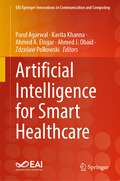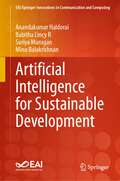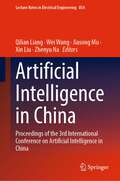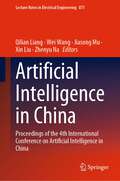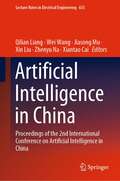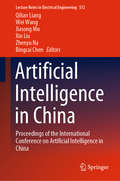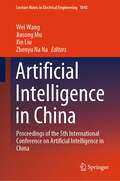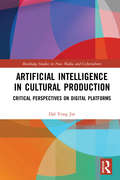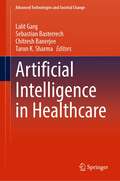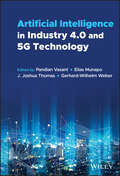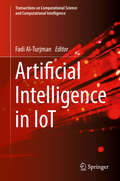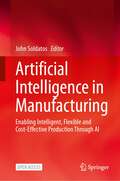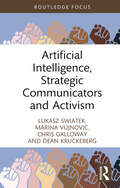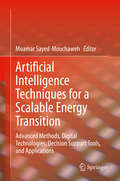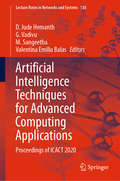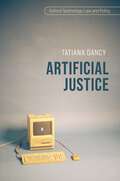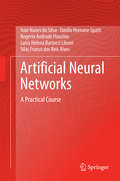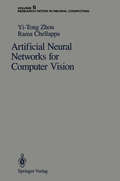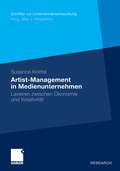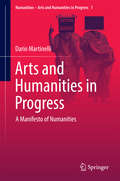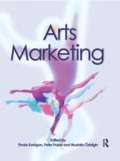- Table View
- List View
Artificial Intelligence for Smart Healthcare (EAI/Springer Innovations in Communication and Computing)
by Parul Agarwal Kavita Khanna Ahmed A. Elngar Ahmed J. Obaid Zdzislaw PolkowskiThis book provides information on interdependencies of medicine and telecommunications engineering and how the two must rely on each other to effectively function in this era. The book discusses new techniques for medical service improvisation such as clear-cut views on medical technologies. The authors provide chapters on communication essentiality in healthcare, processing of medical amenities using medical images, the importance of data and information technology in medicine, and machine learning and artificial intelligence in healthcare. Authors include researchers, academics, and professionals in the field.
Artificial Intelligence for Sustainable Development (EAI/Springer Innovations in Communication and Computing)
by Anandakumar Haldorai Babitha Lincy R Suriya Murugan Minu BalakrishnanThis book delves into the synergy between AI and sustainability. This comprehensive guide illuminates the latest trends and cutting-edge techniques, offering invaluable insights for researchers, practitioners, and policymakers interested in the cross-section of AI and sustainability. The authors illustrate how AI-driven innovations are revolutionizing environmental conservation, urban planning, healthcare, and more. The book also considers the ethical considerations and governance frameworks crucial to harnessing AI's potential for global benefit. Whether a seasoned expert or a curious newcomer, this book empowers readers to navigate the dynamic landscape of AI and sustainability, paving the way for a more eco-conscious and equitable world.
Artificial Intelligence in China: Proceedings of the 3rd International Conference on Artificial Intelligence in China (Lecture Notes in Electrical Engineering #854)
by Qilian Liang Wei Wang Jiasong Mu Xin Liu Zhenyu NaThis book brings together papers presented at the 3rd International Conference on Artificial Intelligence in China (ChinaAI), which provides a venue to disseminate the latest developments and to discuss the interactions and links between these multidisciplinary fields. Spanning topics covering all topics in Artificial Intelligence with new development in China, this book is aimed at undergraduate and graduate students in Electrical Engineering, Computer Science and Mathematics, researchers and engineers from academia and industry as well as government employees (such as NSF, DOD, DOE, etc).
Artificial Intelligence in China: Proceedings of the 4th International Conference on Artificial Intelligence in China (Lecture Notes in Electrical Engineering #871)
by Qilian Liang Wei Wang Jiasong Mu Xin Liu Zhenyu NaThis book brings together papers presented at the 4th International Conference on Artificial Intelligence in China (ChinaAI), Changbaishan, China, on July 23-24, 2022, which provides a venue to disseminate the latest developments and to discuss the interactions and links between these multidisciplinary fields. Spanning topics covering all topics in Artificial Intelligence with new development in China, this book is aimed at undergraduate and graduate students in Electrical Engineering, Computer Science and Mathematics, researchers and engineers from academia and industry as well as government employees (such as NSF, DOD, DOE, etc).
Artificial Intelligence in China: Proceedings of the 2nd International Conference on Artificial Intelligence in China (Lecture Notes in Electrical Engineering #653)
by Qilian Liang Wei Wang Jiasong Mu Xin Liu Zhenyu Na Xiantao CaiThis book brings together papers presented at The 2nd International Conference on Artificial Intelligence in China (ChinaAI) 2020, which provides a venue to disseminate the latest developments and to discuss the interactions and links between these multidisciplinary fields. Spanning topics covering all topics in artificial intelligence with new development in China, this book is aimed at undergraduate and graduate students in Electrical Engineering, Computer Science and Mathematics, researchers and engineers from academia and industry as well as government employees (such as NSF, DOD and DOE).
Artificial Intelligence in China: Proceedings of the International Conference on Artificial Intelligence in China (Lecture Notes in Electrical Engineering #572)
by Qilian Liang Wei Wang Jiasong Mu Xin Liu Zhenyu Na Bingcai ChenThis book brings together papers presented at the International Conference on Artificial Intelligence in China (ChinaAI) 2019, which provided a venue for disseminating the latest advances and discussing the interactions and links between the various subfields of AI. Addressing topics that cover virtually all aspects of AI and the latest developments in China, the book is chiefly intended for undergraduate and graduate students in Electrical Engineering, Computer Science, and Mathematics, for researchers and engineers from academia and industry, and for government employees (e.g. at the NSF, DOD, and DOE).
Artificial Intelligence in China: Proceedings Of The 3rd International Conference On Artificial Intelligence In China (Lecture Notes In Electrical Engineering Ser. #854)
by Wei Wang Jiasong Mu Xin Liu Zhenyu Na NaArtificial Intelligence in Cultural Production: Critical Perspectives on Digital Platforms (Routledge Studies in New Media and Cyberculture)
by Dal Yong JinThis book offers an in-depth academic discourse on the convergence of AI, digital platforms, and popular culture, in order to understand the ways in which the platform and cultural industries have reshaped and developed AI-driven algorithmic cultural production and consumption. At a time of fundamental change for the media and cultural industries, driven by the emergence of big data, algorithms, and AI, the book examines how media ecology and popular culture are evolving to serve the needs of both media and cultural industries and consumers. The analysis documents global governments’ rapid development of AI-relevant policies and identifies key policy issues; examines the ways in which cultural industries firms utilize AI and algorithms to advance the new forms of cultural production and distribution; investigates change in cultural consumption by analyzing the ways in which AI, algorithms, and digital platforms reshape people’s consumption habits; and examines whether governments and corporations have advanced reliable public and corporate policies and ethical codes to secure socio-economic equality. Offering a unique perspective on this timely and vital issue, this book will be of interest to scholars and students in media studies, communication studies, anthropology, globalization studies, sociology, cultural studies, Asian studies, and science and technology studies (STS).
Artificial Intelligence in Cultural Production: Critical Perspectives on Digital Platforms (Routledge Studies in New Media and Cyberculture)
by Dal Yong JinThis book offers an in-depth academic discourse on the convergence of AI, digital platforms, and popular culture, in order to understand the ways in which the platform and cultural industries have reshaped and developed AI-driven algorithmic cultural production and consumption. At a time of fundamental change for the media and cultural industries, driven by the emergence of big data, algorithms, and AI, the book examines how media ecology and popular culture are evolving to serve the needs of both media and cultural industries and consumers. The analysis documents global governments’ rapid development of AI-relevant policies and identifies key policy issues; examines the ways in which cultural industries firms utilize AI and algorithms to advance the new forms of cultural production and distribution; investigates change in cultural consumption by analyzing the ways in which AI, algorithms, and digital platforms reshape people’s consumption habits; and examines whether governments and corporations have advanced reliable public and corporate policies and ethical codes to secure socio-economic equality. Offering a unique perspective on this timely and vital issue, this book will be of interest to scholars and students in media studies, communication studies, anthropology, globalization studies, sociology, cultural studies, Asian studies, and science and technology studies (STS).
Artificial Intelligence in Healthcare (Advanced Technologies and Societal Change)
by Lalit Garg Sebastian Basterrech Chitresh Banerjee Tarun K. SharmaThis book highlights the analytics and optimization issues in healthcare systems, proposes new approaches, and presents applications of innovative approaches in real facilities. In the past few decades, there has been an exponential rise in the application of swarm intelligence techniques for solving complex and intricate problems arising in healthcare. The versatility of these techniques has made them a favorite among scientists and researchers working in diverse areas. The primary objective of this book is to bring forward thorough, in-depth, and well-focused developments of hybrid variants of swarm intelligence algorithms and their applications in healthcare systems.
Artificial Intelligence in Industry 4.0 and 5G Technology
by Pandian Vasant Elias Munapo J. Joshua Thomas Gerhard-Wilhelm WeberArtificial Intelligence in Industry 4.0 and 5G Technology Explores innovative and value-added solutions for application problems in the commercial, business, and industry sectors As the pace of Artificial Intelligence (AI) technology innovation continues to accelerate, identifying the appropriate AI capabilities to embed in key decision processes has never been more critical to establishing competitive advantage. New and emerging analytics tools and technologies can be configured to optimize business value, change how an organization gains insights, and significantly improve the decision-making process across the enterprise. Artificial Intelligence in Industry 4.0 and 5G Technology helps readers solve real-world technological engineering optimization problems using evolutionary and swarm intelligence, mathematical programming, multi-objective optimization, and other cutting-edge intelligent optimization methods. Contributions from leading experts in the field present original research on both the theoretical and practical aspects of implementing new AI techniques in a variety of sectors, including Big Data analytics, smart manufacturing, renewable energy, smart cities, robotics, and the Internet of Things (IoT). Presents detailed information on meta-heuristic applications with a focus on technology and engineering sectors such as smart manufacturing, smart production, innovative cities, and 5G networks. Offers insights into the use of metaheuristic strategies to solve optimization problems in business, economics, finance, and industry where uncertainty is a factor. Provides guidance on implementing metaheuristics in different applications and hybrid technological systems. Describes various AI approaches utilizing hybrid meta-heuristics optimization algorithms, including meta-search engines for innovative research and hyper-heuristics algorithms for performance measurement. Artificial Intelligence in Industry 4.0 and 5G Technology is a valuable resource for IT specialists, industry professionals, managers and executives, researchers, scientists, engineers, and advanced students an up-to-date reference to innovative computing, uncertainty management, and optimization approaches.
Artificial Intelligence in Industry 4.0 and 5G Technology
by Pandian Vasant Elias Munapo Joshua Thomas Gerhard Wilhelm WeberArtificial Intelligence in Industry 4.0 and 5G Technology Explores innovative and value-added solutions for application problems in the commercial, business, and industry sectors As the pace of Artificial Intelligence (AI) technology innovation continues to accelerate, identifying the appropriate AI capabilities to embed in key decision processes has never been more critical to establishing competitive advantage. New and emerging analytics tools and technologies can be configured to optimize business value, change how an organization gains insights, and significantly improve the decision-making process across the enterprise. Artificial Intelligence in Industry 4.0 and 5G Technology helps readers solve real-world technological engineering optimization problems using evolutionary and swarm intelligence, mathematical programming, multi-objective optimization, and other cutting-edge intelligent optimization methods. Contributions from leading experts in the field present original research on both the theoretical and practical aspects of implementing new AI techniques in a variety of sectors, including Big Data analytics, smart manufacturing, renewable energy, smart cities, robotics, and the Internet of Things (IoT). Presents detailed information on meta-heuristic applications with a focus on technology and engineering sectors such as smart manufacturing, smart production, innovative cities, and 5G networks. Offers insights into the use of metaheuristic strategies to solve optimization problems in business, economics, finance, and industry where uncertainty is a factor. Provides guidance on implementing metaheuristics in different applications and hybrid technological systems. Describes various AI approaches utilizing hybrid meta-heuristics optimization algorithms, including meta-search engines for innovative research and hyper-heuristics algorithms for performance measurement. Artificial Intelligence in Industry 4.0 and 5G Technology is a valuable resource for IT specialists, industry professionals, managers and executives, researchers, scientists, engineers, and advanced students an up-to-date reference to innovative computing, uncertainty management, and optimization approaches.
Artificial Intelligence in IoT (Transactions on Computational Science and Computational Intelligence)
by Fadi Al-TurjmanThis book provides an insight into IoT intelligence in terms of applications and algorithmic challenges. The book is dedicated to addressing the major challenges in realizing the artificial intelligence in IoT-based applications including challenges that vary from cost and energy efficiency to availability to service quality in multidisciplinary fashion. The aim of this book is hence to focus on both the algorithmic and practical parts of the artificial intelligence approaches in IoT applications that are enabled and supported by wireless sensor networks and cellular networks. Targeted readers are from varying disciplines who are interested in implementing the smart planet/environments vision via intelligent wireless/wired enabling technologies.Includes the most up-to-date research and applications related to IoT artificial intelligence (AI);Provides new and innovative operational ideas regarding the IoT artificial intelligence that help advance the telecommunications industry;Presents AI challenges facing the IoT scientists and provides potential ways to solve them in critical daily life issues.
Artificial Intelligence in Manufacturing: Enabling Intelligent, Flexible and Cost-Effective Production Through AI
by John SoldatosThis open access book presents a rich set of innovative solutions for artificial intelligence (AI) in manufacturing. The various chapters of the book provide a broad coverage of AI systems for state of the art flexible production lines including both cyber-physical production systems (Industry 4.0) and emerging trustworthy and human-centered manufacturing systems (Industry 5.0). From a technology perspective, the book addresses a wide range of AI paradigms such as deep learning, reinforcement learning, active learning, agent-based systems, explainable AI, industrial robots, and AI-based digital twins. Emphasis is put on system architectures and technologies that foster human-AI collaboration based on trusted interactions between workers and AI systems. From a manufacturing applications perspective, the book illustrates the deployment of these AI paradigms in a variety of use cases spanning production planning, quality control, anomaly detection, metrology, workers’ training, supply chain management, as well as various production optimization scenarios. This is an open access book.
Artificial Intelligence, Strategic Communicators and Activism (Global PR Insights)
by Lukasz Swiatek Marina Vujnovic Chris Galloway Dean KruckebergIn a world that is increasingly wary of artificial intelligence (AI), this book explores the pressing need for strategic communicators to move away from being advocates for AI and move towards a more critical activist role that enables them to counter AI-driven threats to communities and relationships. AI is contributing to inequality, misinformation and environmental damage, among other problems. This book argues that strategic communicators are uniquely placed to help counter AI-driven challenges because of their skills in relationship-building and their ability to craft and deliver messages effectively. By discussing the different professional activist approaches that communicators can take in relation to growing AI challenges, the book offers multiple perspectives that will help to build knowledge in diverse settings and develop practice, especially in community and activist strategic communication. Research-based and combining theory with practice, this thought-provoking book will be welcomed by strategic communication scholars and practitioners alike eager to develop a critical approach to the challenges surrounding AI.
Artificial Intelligence, Strategic Communicators and Activism (Global PR Insights)
by Lukasz Swiatek Marina Vujnovic Chris Galloway Dean KruckebergIn a world that is increasingly wary of artificial intelligence (AI), this book explores the pressing need for strategic communicators to move away from being advocates for AI and move towards a more critical activist role that enables them to counter AI-driven threats to communities and relationships. AI is contributing to inequality, misinformation and environmental damage, among other problems. This book argues that strategic communicators are uniquely placed to help counter AI-driven challenges because of their skills in relationship-building and their ability to craft and deliver messages effectively. By discussing the different professional activist approaches that communicators can take in relation to growing AI challenges, the book offers multiple perspectives that will help to build knowledge in diverse settings and develop practice, especially in community and activist strategic communication. Research-based and combining theory with practice, this thought-provoking book will be welcomed by strategic communication scholars and practitioners alike eager to develop a critical approach to the challenges surrounding AI.
Artificial Intelligence Techniques for a Scalable Energy Transition: Advanced Methods, Digital Technologies, Decision Support Tools, and Applications
by Moamar Sayed-MouchawehThis book presents research in artificial techniques using intelligence for energy transition, outlining several applications including production systems, energy production, energy distribution, energy management, renewable energy production, cyber security, industry 4.0 and internet of things etc. The book goes beyond standard application by placing a specific focus on the use of AI techniques to address the challenges related to the different applications and topics of energy transition. The contributions are classified according to the market and actor interactions (service providers, manufacturers, customers, integrators, utilities etc.), to the SG architecture model (physical layer, infrastructure layer, and business layer), to the digital twin of SG (business model, operational model, fault/transient model, and asset model), and to the application domain (demand side management, load monitoring, micro grids, energy consulting (residents, utilities), energy saving, dynamic pricing revenue management and smart meters, etc.).
Artificial Intelligence Techniques for Advanced Computing Applications: Proceedings of ICACT 2020 (Lecture Notes in Networks and Systems #130)
by D. Jude Hemanth G. Vadivu M. Sangeetha Valentina Emilia BalasThis book features a collection of high-quality research papers presented at the International Conference on Advanced Computing Technology (ICACT 2020), held at the SRM Institute of Science and Technology, Chennai, India, on 23–24 January 2020. It covers the areas of computational intelligence, artificial intelligence, machine learning, deep learning, big data, and applications of artificial intelligence in networking, IoT and bioinformatics
Artificial Justice (Oxford Technology Law and Policy)
by Tatiana DancyImagine that Eric, a young man, has been convicted of a gang-related crime: he was found by police at the scene of a robbery carried out by his friends. The sentencing judge now needs to make a decision. Not knowing whether Eric poses a risk to the public, she turns to an algorithmic risk assessment - a set of rules, developed on the basis of correlations between individual characteristics and criminal activity, which predicts the likelihood of recidivism. Eric is a conscientious citizen, who has never before been in trouble with the law. However, he was raised in foster care, in an area with high rates of crime, poverty, and residential instability- facts to which the algorithm attributes a high risk score. The judge recommends a sentence of the maximum possible duration, with extended post-release supervision. Why does this matter? The answer most often given is that it matters because of inequality, captured through the language of 'bias' or 'discrimination': the effect of using algorithms can be to exacerbate unjustified differences between people, on the basis of considerations such as race, sex, or socio-economic circumstance. Using a diverse set of case studies, and making clear policy recommendations along the way, Artificial Justice unpacks the reasons that we might have to object to the use of statistical algorithms to allocate the burdens of policy decisions. It argues that these reasons extend beyond egalitarian concerns. Importantly, they include reasons that stem from the value of individual choice - of having the chance to affect what happens to us by choosing appropriately and being equipped to exercise those choices well. The book explores the substantive reasons that contribute to a picture of what's at stake for individuals when we use statistical algorithms to make decisions about how to treat others, and makes robust policy recommendations about the scope and nature of human-algorithm interaction. Artificial Justice is a compelling and accessible text, which offers a great deal to a wide and interdisciplinary audience of academics, students, and those otherwise interested in learning about algorithmic justice.
Artificial Justice (Oxford Technology Law and Policy)
by Tatiana DancyImagine that Eric, a young man, has been convicted of a gang-related crime: he was found by police at the scene of a robbery carried out by his friends. The sentencing judge now needs to make a decision. Not knowing whether Eric poses a risk to the public, she turns to an algorithmic risk assessment - a set of rules, developed on the basis of correlations between individual characteristics and criminal activity, which predicts the likelihood of recidivism. Eric is a conscientious citizen, who has never before been in trouble with the law. However, he was raised in foster care, in an area with high rates of crime, poverty, and residential instability- facts to which the algorithm attributes a high risk score. The judge recommends a sentence of the maximum possible duration, with extended post-release supervision. Why does this matter? The answer most often given is that it matters because of inequality, captured through the language of 'bias' or 'discrimination': the effect of using algorithms can be to exacerbate unjustified differences between people, on the basis of considerations such as race, sex, or socio-economic circumstance. Using a diverse set of case studies, and making clear policy recommendations along the way, Artificial Justice unpacks the reasons that we might have to object to the use of statistical algorithms to allocate the burdens of policy decisions. It argues that these reasons extend beyond egalitarian concerns. Importantly, they include reasons that stem from the value of individual choice - of having the chance to affect what happens to us by choosing appropriately and being equipped to exercise those choices well. The book explores the substantive reasons that contribute to a picture of what's at stake for individuals when we use statistical algorithms to make decisions about how to treat others, and makes robust policy recommendations about the scope and nature of human-algorithm interaction. Artificial Justice is a compelling and accessible text, which offers a great deal to a wide and interdisciplinary audience of academics, students, and those otherwise interested in learning about algorithmic justice.
Artificial Neural Networks: A Practical Course
by Ivan Nunes da Silva Danilo Hernane Spatti Rogerio Andrade Flauzino Luisa Helena Liboni Silas Franco dos Reis AlvesThis book provides comprehensive coverage of neural networks, their evolution, their structure, the problems they can solve, and their applications. The first half of the book looks at theoretical investigations on artificial neural networks and addresses the key architectures that are capable of implementation in various application scenarios. The second half is designed specifically for the production of solutions using artificial neural networks to solve practical problems arising from different areas of knowledge. It also describes the various implementation details that were taken into account to achieve the reported results. These aspects contribute to the maturation and improvement of experimental techniques to specify the neural network architecture that is most appropriate for a particular application scope. The book is appropriate for students in graduate and upper undergraduate courses in addition to researchers and professionals.
Artificial Neural Networks for Computer Vision (Research Notes in Neural Computing #5)
by Yi-Tong Zhou Rama ChellappaThis monograph is an outgrowth of the authors' recent research on the de velopment of algorithms for several low-level vision problems using artificial neural networks. Specific problems considered are static and motion stereo, computation of optical flow, and deblurring an image. From a mathematical point of view, these inverse problems are ill-posed according to Hadamard. Researchers in computer vision have taken the "regularization" approach to these problems, where one comes up with an appropriate energy or cost function and finds a minimum. Additional constraints such as smoothness, integrability of surfaces, and preservation of discontinuities are added to the cost function explicitly or implicitly. Depending on the nature of the inver sion to be performed and the constraints, the cost function could exhibit several minima. Optimization of such nonconvex functions can be quite involved. Although progress has been made in making techniques such as simulated annealing computationally more reasonable, it is our view that one can often find satisfactory solutions using deterministic optimization algorithms.
Artist-Management in Medienunternehmen: Lavieren zwischen Ökonomie und Kreativität (Schriften zur Unternehmensentwicklung)
by Susanne KnittelSusanne Knittel zeigt die besondere Rolle von Artists als Kreativressourcen von Medienunternehmen. Sie stellt mit dem Kreativressourcen-Lebenszyklus einen Bezugsrahmen vor und entwickelt darauf basierend ein Konzept für das strategische Management von Artists.
Arts and Humanities in Progress: A Manifesto of Numanities (Numanities - Arts and Humanities in Progress #1)
by Dario MartinelliThe book aims to introduce a research concept called "Numanities", as one possible attempt to overcome the current scientific, social and institutional crisis of the humanities. Such crisis involves their impact on, and role within, society; their popularity among students and scholars; and their identity as producers and promoters of knowledge. The modern western world and its economic policies have been identified as the strongest cause of such a crisis. Creating the conditions for, but in fact encouraging it. However, a self-critical assessment of the situation is called for. Our primary fault as humanists was that of stubbornly thinking that the world’s changes could never really affect us, as – we felt – our identity was sacred. In the light of these approaches, the main strengths of humanities have been identified in the ability to: promote critical thinking and analytical reasoning; provide knowledge and understanding of democracy and social justice; develop leadership, cultural and ethical values. The main problems of humanities are the lack economic relevance; the socio-institutional perception of them as “impractical” and unemployable; the fact that they do not match with technological development. Finally, the resulting crisis consists mainly in the absence (or radical reduction) of funding from institutions; a decrease in student numbers a decrease in interest; a loss of centrality in society. A Numanities (New Humanities) project should consider all these aspects, with self-critical assessment on the first line. The goal is to unify the various fields, approaches and also potentials of the humanities in the context, dynamics and problems of current societies, and in an attempt to overcome the above-described crisis. Numanities are introduced not as a theoretical paradigm, but in terms of an “umbrella-concept” that has no specific scientific content in it: that particularly means that the many existing new fields and research trends that are addressing the same problems (post-humanism, transhumanism, transformational humanities, etc.) are not competitors of Numanities, but rather possible ways to them. Therefore, more than a theoretical program, Numanities intend to pursue a mission, and that is summarized in a seven-point manifesto. In the light of these premises and reflections, the book then proceeds to identify the areas of inquiry that Numanities, in their functions and comprehensive approach, seek to cover. The following list should also be understood as a statement of purposes for this entire book series. These, in other words, will be the topics/areas we intend to represent. Once elaborated on the foundations of Numanities, the book features a second part that presents two case studies based on two relatively recent (and now updated) investigations that the author has performed in the fields of musical and animal studies respectively. The two cases (and relative areas of inquiry) were selected because they were considered particularly relevant within the discussion of Numanities, and in two different ways. In the first case-study the author discussed the most typical result (or perhaps cause?) of the technophobic attitude that was addressed in the first part of the book: the issue of “authenticity”, as applied, in the author's particular study, to popular music. In the second case-study, he analyzes two different forms of comparative analysis between human and non-human cognition: like in the former case, this study, too, is aimed at a critical commentary on (what the author considers) redundant biases in current humanistic research – anthropocentrism and speciesism.
Arts Marketing (PDF)
by Finola Kerrigan Peter Fraser Mustafa ÖzbilginArts Marketing focuses on a variety of sectors within the arts and addresses the way in which marketing principles are applied within these, outlining both the similarities and the differences that occur. Relating policy to practice, this contributed text demonstrates the most effective means of marketing in specific areas of the arts, with each chapter having been written by a specialist in the field. Although primarily focusing on the UK market, the subject has global relevance and appeal, and policy is evaluated on national, European and supranational levels. Specialist topics dealt with range from the marketing of the theatre, opera, and museums, through to the film industry and popular music. Arts Marketing focuses on a variety of sectors within the arts and addresses the way in which marketing principles are applied within these, outlining both the similarities and the differences that occur. Relating policy to practice, this contributed text demonstrates the most effective means of marketing in specific areas of the arts, with each chapter having been written by a specialist in the field. Although primarily focusing on the UK market, the subject has global relevance and appeal, and policy is evaluated on national, European and supranational levels. Specialist topics dealt with range from the marketing of the theatre, opera, and museums, through to the film industry and popular music.
